Views: 0 Author: Site Editor Publish Time: 2025-08-02 Origin: Site







Choosing the right AOI machine in 2025 has never been harder — every brand claims “AI-powered,” “3D-capable,” and “factory-smart,” yet the real differences are often buried under marketing buzzwords. That’s exactly why we created this guide. If you’re comparing multiple AOI options and feeling that familiar decision-fatigue kicking in, this article cuts through the noise with a clear, neutral, side-by-side perspective. Our goal is simple: highlight what genuinely separates today’s top AOI systems so you can pick the one that fits your production line, not just the one that sounds the best on paper.

Automatic optical inspection is very important in surface mount technology. It uses cameras and smart software to look at printed circuit board assemblies. The system finds problems like missing or crooked parts, bad soldering, and things that should not be there. Automated optical inspection works at different steps in the SMT assembly line. It checks after solder paste is put on, before and after reflow soldering, and during wave soldering. These systems help makers keep electronics high quality by spotting issues early. Automated optical inspection makes sure each board is good before it moves on.
Manufacturers use automatic optical inspection to make quality better and save money. These systems find problems right away, so workers can fix them fast. AOI finds many types of mistakes, like wrong polarity, bad soldering, and missing or crooked parts. The technology uses different ways to inspect, like 3D pictures and cameras from many angles. This helps with hard things like bent boards and shiny surfaces. Automated optical inspection system also work with manufacturing execution systems. They give quick feedback and track every defect to the right step.
Automatic optical inspection makes results more steady and trustworthy than people can. It helps factories get better all the time and meet the needs of new electronics.
AOI technology is moving fast in 2025 — faster than most buyers can comfortably keep up with. Manufacturers are pushing AI-driven defect recognition, advanced 3D height inspection, and fully connected factory ecosystems, while production teams are trying to figure out which upgrades actually matter to their line. To make this easier, the “Top 5” in our guide isn’t based on hype or brand size, but on a balanced evaluation across five core dimensions: inspection performance, real-world stability, cost-to-value ratio, software intelligence, and global market adoption.
These rankings come from publicly available information across reputable industry sources — including platforms such as SMTnet, IPC reports, AOI manufacturers’ published specifications, and real user feedback shared across professional SMT communities. By combining trends and verified data, our goal is to give you a clear, unbiased view of what’s actually shaping AOI development in 2025, and what to expect when comparing machines side-by-side for your next investment.
Founded: 2002
Hot Sale Model: ICT‑5146
PCB Size: 460 × 460 mm
Machine Size: W1100 × D1300 × H1450 mm
Website: www.smtfactory.com
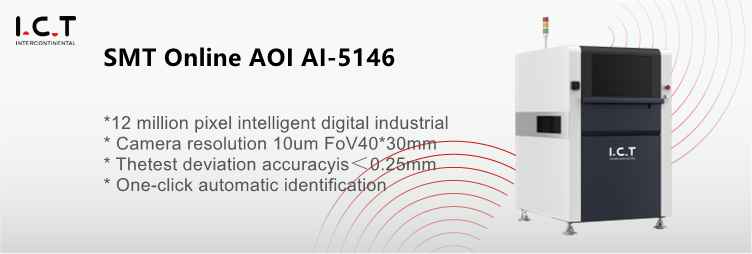
Utilizes deep learning CNN for automatic component and solder joint identification.
Achieves low false alarms with GR&R under 10% and high stability.
Handles complex scenarios like deviations and irregular parts effectively.
Inspects at 0.23 seconds per FOV with real-time computation.
Supports mixed boards, materials, and multiple production modes flexibly.
Enables remote management, MES integration for efficient data tracing.
Pros | Cons |
AI reduces false alarms vs traditional. | 2D lacks 3D height. |
Speed matches Koh Young Zenith. | PCB size limited 510x460mm. |
Remote management outperforms locals. | |
Flexible mixed modes superior. |
The I.C.T AI-5146 AOI machine is available globally, with presence in the US, Germany, UK, South Korea, Japan, Thailand, Malaysia, India, Vietnam, and South America. Customers looking for reliable AOI solutions can purchase directly from I.C.T or through trusted local distributors, ensuring both accessibility and responsive support.
Positioned as a mid-to-high-end option, the AI-5146 delivers superior performance compared to entry-level AOI models like the off line mode I.C.T‑V8, while remaining more cost-effective than premium 3D systems such as the AI-5133D. This balance makes it ideal for small-to-large EMS companies and OEMs across industries including consumer electronics, automotive, LED lighting, and industrial control. Manufacturers favor the AI-5146 for its high-speed inspection capabilities and reliable defect detection, providing consistent quality assurance for modern SMT production lines.
Founded: 1975
Hot Sale Model: Saki 3Di‑LS2
PCB Size: 510 × 510 mm
Machine Size: W1150 × D1400 × H1500 mm
Website: www.sakicorp.com
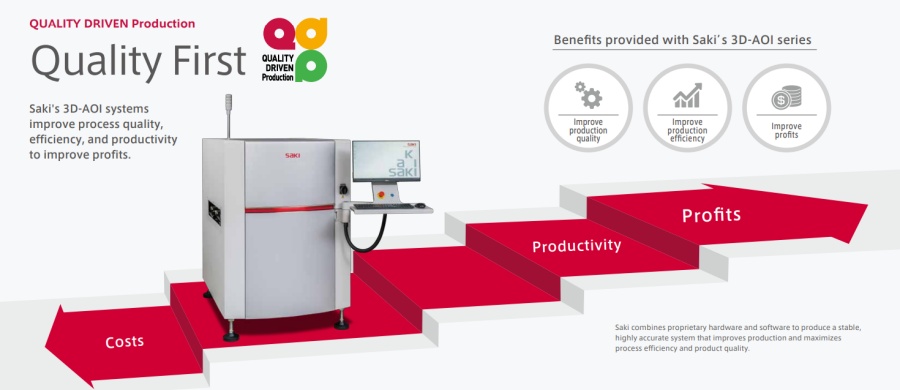
The Saki 3Di‑LS2 AOI equipment is designed for high-mix, high-volume SMT production, combining fast 2D/3D inspection with robust defect detection. Widely used in automotive, medical electronics, consumer devices, and industrial control, it balances precision and throughput for manufacturers seeking reliable quality assurance. Saki’s modular design allows easy integration into existing lines, making it a versatile choice for EMS providers and OEMs looking to minimize rework and maximize yield.
3Di‑LS2 3D inspection for dense PCB assemblies
AI-powered defect recognition for minimal false calls
High-speed inspection for high-mix production
Advanced analytics for process optimization
Compact footprint for space-limited lines
Reliable for medical, automotive, and industrial applications
Pros | Cons |
AI checks lower mistakes by people | The machine is heavy, about 900 kg |
You can change lights and cameras | First setup might take some time |
Checks both SMT and through-hole parts | Takes up a lot of space |
Fast and good 3D checks | |
Big car makers trust it |
The Saki 3Di‑LS2 AOI equipment is widely available across North America, Europe, and Asia, including countries such as the US, Germany, UK, Japan, South Korea, Thailand, and India. Saki works directly with distributors and service partners worldwide, ensuring customers have easy access to machines and reliable technical support.
As a high-performance mid-to-premium AOI system, the 3Di‑LS2 excels in both 2D and 3D inspection, making it suitable for high-mix, high-volume SMT production. Its strength lies in fast, accurate defect detection and advanced 3D capabilities, offering superior inspection for automotive, medical electronics, industrial control, and consumer devices. Manufacturers favor Saki AOI equipment when precision and process reliability are critical, especially for complex or densely populated PCB.
Founded: 1991
Hot Sale Model: MV‑7L
PCB Size: 460 × 510 mm
Machine Size: W1200 × D1350 × H1500 mm
Website: www.mirtec.com
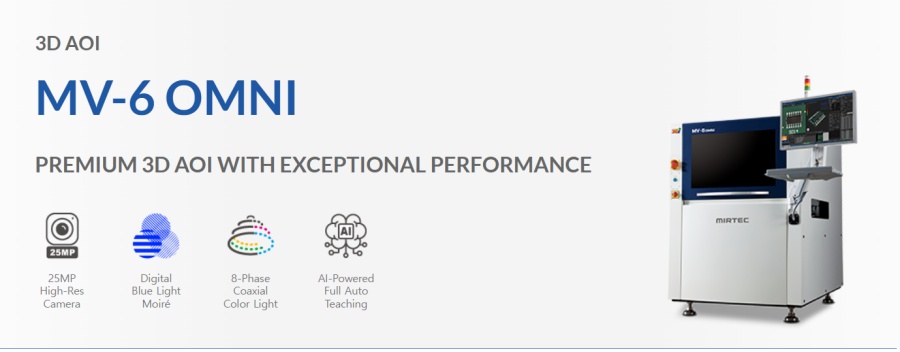
The Mirtec MV-6 OMNI is a top 3D AOI PCB inspection equipment for electronics. It uses sharp pictures and 3D checks with special OMNI-VISION® tech. Experts like this machine and it has won awards. Makers pick it for its strong checks and better quality control.
V-INSPECT 3D inspection for complex boards
High throughput and stable operation
Handles large and densely populated PCBs
Advanced defect classification and reporting
Supports traceability and compliance
Optimized for automotive, LED, and high-reliability sectors
Pros | Cons |
Checks in 3D and 2D with sharp images | The machine is heavy (950 kg) |
Finds problems fast and well | Needs skilled setup for some tools |
You can fix things without stopping | May be too big for some lines |
Known for new ideas and being steady | |
Fits many board sizes |
The MIRTEC MV‑7L AOI machine is available globally, with a strong presence in the US, Germany, UK, Japan, South Korea, Thailand, Malaysia, and India. MIRTEC partners with authorized distributors to provide comprehensive support and ensure that buyers have direct access to both machines and service networks.
Positioned as a premium AOI option, the MV‑7L delivers exceptional inspection speed, 3D accuracy, and adaptability across a wide range of PCB sizes and component types. It is highly suited for EMS providers, OEMs, and high-tech electronics manufacturers, including automotive, LED, and industrial automation sectors. Its combination of high throughput and detailed defect analysis makes it a preferred choice for companies prioritizing quality and efficiency in high-volume SMT production.
Founded: 1983
Hot Sale Model: Zenith‑KSMART 3D
PCB Size: 510 × 510 mm
Machine Size: W1250 × D1450 × H1550 mm
Website: www.kohyoung.com
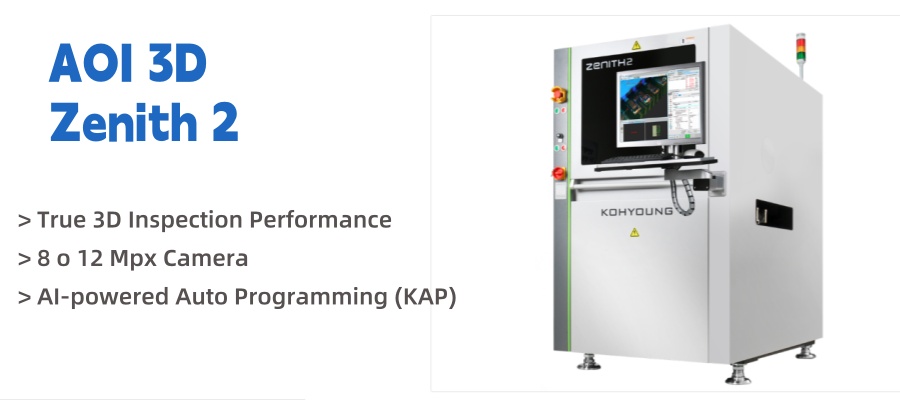
The Koh Young Zenith 2 is a top machine for checking SMT boards. It uses special True 3D technology to make exact 3D shapes of each PCB. The AOI Testing Machine measures how high, wide, and flat the solder joints and parts are. Zenith 2 checks boards using IPC-A-610 rules, which are trusted everywhere for electronics. The system has AI-powered auto programming, so setup is quick and simple. Zenith 2 links with the KSMART smart factory system. This lets it share data right away and fix problems fast. When used with the KPO Mounter, it makes a closed-loop system. This helps place parts better and makes the line work faster.
Zenith‑3D inspection with AI algorithms
Seamless MES and factory system integration
High-mix PCB flexibility for variable production
Consistent throughput and minimal rework
Detailed defect analysis for complex boards
Ideal for high-reliability automotive and industrial lines
Pros | Cons |
Best True 3D checks in the industry | Costs more at first |
Fast, AI setup means less waiting | Some features need training to use well |
Closed-loop fixing makes things more correct | Needs more space in some factories |
Predicts care needs to stop surprise breakdowns | |
Follows IPC rules very well |
The Koh Young Zenith‑KSMART 3D AOI is available across major global markets, including the US, Germany, UK, Japan, South Korea, Thailand, Vietnam, and India. Koh Young offers both direct sales and trusted distributor partnerships to ensure reliable machine delivery and post-sales support worldwide.
This high-end automated optical inspection system stands out for its advanced 3D inspection, AI-powered defect recognition, and seamless MES integration, making it ideal for high-mix, high-reliability industries such as automotive electronics, medical devices, and consumer electronics. Manufacturers choose Koh Young AOI machines for precision defect detection, consistent throughput, and reduced rework rates, supporting complex SMT lines where quality is paramount.
Founded: 1933
Hot Sale Model: VT‑S530
PCB Size: 500 × 500 mm
Machine Size: W1300 × D1500 × H1600 mm
Website: www.automation.omron.com
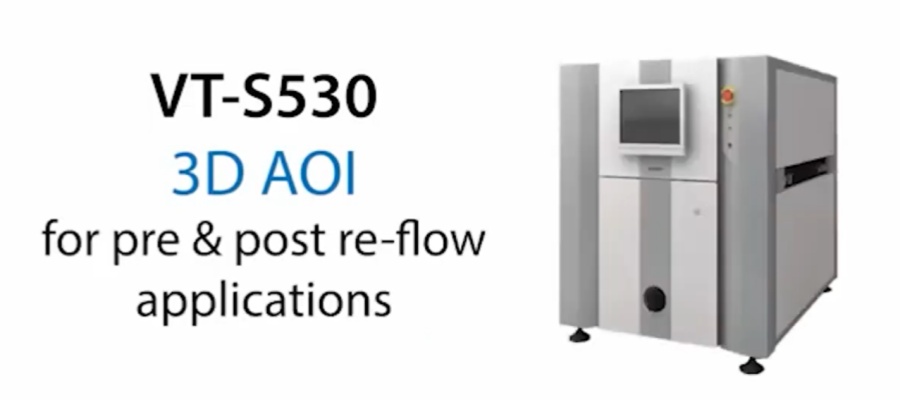
The Omron VT-S530 gives full 3D-AOI checks for SMT lines. This machine uses smart cameras and mixes Phase Shift with color highlight™ 3D shape tech. The VT-S530 gets high first-pass yield, no missed problems, and very few wrong rejects. It checks boards before and after soldering. It can work with one or two lines and checks very big PCBs up to 510x680 mm. The system follows IPC rules and checks even tiny 01005 parts. Omron’s special 3D-SJI COMBO tech makes sure every board is checked well.
OMNI-VISION® 3D checks for complex boards
AI-assisted defect analysis with real-time feedback
Ultra-fast 2D/3D scanning for high-volume lines
Handles dense and complex PCB assemblies
Extremely robust with minimal downtime
Integrated quality control for mission-critical production
Pros | Cons |
Full 3D-AOI with smart 3D-SJI tech | Costs more than simple AOI |
Checks big and small PCBs, even 01005 parts | Needs more space on the line |
Two-line use makes more products | Some features need training |
Watches the line and helps fix problems right away | |
Easy to use and has strong support |
The Omron VT‑S530 PCB inspection machine is widely deployed in the US, Germany, UK, Japan, South Korea, Thailand, Malaysia, India, and South America. Omron supports buyers via both direct sales and global distributor networks, providing easy access and reliable technical assistance wherever production is located.
As a top-tier PCB inspection machine, the VT‑S530 combines high-speed inspection, versatile PCB handling, and advanced AI analysis to deliver precise defect detection for complex SMT boards. It is favored by OEMs and EMS providers in automotive, consumer electronics, industrial control, and LED sectors, especially where high throughput and consistent quality are critical. Omron machines are particularly valued for robust performance, minimal downtime, and strong global support, making them a safe choice for large-scale or mission-critical production lines.
I.C.T – Ranked 5th
The I.C.T AI‑5146D AOI machine combines a proprietary 3D vision module with AI-assisted defect detection, supporting small to large PCBs and offering mid-to-high throughput for EMS and OEMs. It is widely used in consumer electronics, automotive, and LED lighting, providing a balanced performance-to-price ratio and modular design that enables easy integration into existing SMT lines. This makes it ideal for manufacturers seeking reliable inspection without overspending.
Saki – Ranked 4th
The Saki 3Di‑LS2 AOI machine features 3Di‑LS2 3D inspection technology with AI recognition, optimized for high-mix, high-volume production. Capable of handling medium to large PCBs at high inspection speeds, it is commonly deployed in automotive, medical electronics, and consumer device lines. Its compact footprint and advanced analytics allow efficient integration into tight SMT lines while minimizing false calls and maintaining high precision.
Mirtec – Ranked 3rd
The MIRTEC MV‑7L AOI excels with V-INSPECT 3D technology, delivering ultra-accurate defect detection for complex automotive, LED, and consumer electronics boards. Supporting medium to large, densely populated PCBs with high throughput, it combines stable performance, detailed defect classification, and full traceability, making it ideal for manufacturers that prioritize precision and compliance in high-value boards.
Koh Young – Ranked 2nd
The Koh Young Zenith‑KSMART 3D AOI integrates Zenith‑3D inspection with AI algorithms and MES system connectivity, offering consistent throughput, minimal rework, and precise defect detection. It supports small to large PCBs and is widely adopted in automotive, medical, and industrial electronics. Its strength lies in high-reliability production environments, where manufacturers need both accuracy and seamless factory system integration.
Omron – Ranked 1st
The Omron VT‑S530 AOI features OMNI-VISION® 3D checks combined with AI-assisted defect analysis, designed for ultra-fast 2D/3D inspection of medium to large, highly dense PCBs. Commonly used in automotive, consumer electronics, LED, and industrial control lines, it provides robust performance, minimal downtime, and real-time feedback, making it ideal for high-volume, mission-critical production where reliability and speed are paramount.
Summary
This overview focuses on the top five AOI systems that are most widely adopted and recognized for high-volume, high-precision SMT production. While brands like Mycronic, Vitrox, Pemtron, and MEK also offer AOI solutions, they were not included in this comparison for several reasons:
Focus on global adoption and support: The five selected brands—Omron, Koh Young, Mirtec, Saki, and I.C.T—have extensive global presence, ensuring widespread service networks and parts availability for manufacturers worldwide.
Proven track record in key industries: These systems are widely deployed in automotive, medical, industrial, and consumer electronics lines, with documented performance and integration in large-scale production.
Comparison consistency: The selection criteria—inspection speed, 3D/AI capabilities, throughput, and line integration—provide a consistent basis for comparison, making these five brands suitable for illustrating key differences in leading AOI technology.
By focusing on these five, manufacturers get a clear, practical view of the leading AOI solutions, enabling them to make informed decisions without being overwhelmed by less relevant options.
AOI means Automated Optical Inspection. This uses cameras and software to check printed circuit boards. It looks for problems while the boards are being made.
3D AOI checks how tall and shaped parts and solder joints are. 2D AOI only takes flat pictures. 3D AOI finds more problems and checks better.
Factories use AI in AOI equipment to find problems better. AI learns from old checks and makes fewer false alarms. This helps make products better and saves time.
Most AOI PCB inspection machine can check many kinds of PCB. They work with single, double, and multi-layer boards. Some machines are better for big or thick boards.
Makers say to clean AOI inspection machine every day and check them each month. A pro should look at them once a year. Regular care keeps AOI machines working well.
MES means Manufacturing Execution System. AOI machines with MES can share check data right away. This helps track problems and makes the whole line better.
New AOI equipment have easy software and AI to help set up. Most workers can start new checks fast, usually in under 30 minutes.
Factories often get their money back in one or two years. AOI machines lower mistakes, cut fixing costs, and speed up work. This saves a lot of money over time.